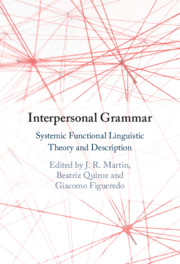Book contents
- Interpersonal Grammar
- Interpersonal Grammar
- Copyright page
- Contents
- Figures
- Tables
- Contributors
- 1 Introduction: Theory and Description in Interpersonal Grammar across Languages
- 2 Interpersonal Grammar in Spanish
- 3 Interpersonal Grammar in Khorchin Mongolian
- 4 Interpersonal Grammar in Mandarin
- 5 Interpersonal Grammar in Tagalog: Assessment Systems
- 6 Interpersonal Grammar of Pitjantjatjara
- 7 Interpersonal Grammar in Brazilian Portuguese
- 8 Interpersonal Grammar in British Sign Language
- 9 Interpersonal Grammar in Scottish Gaelic
- Index
- References
1 - Introduction: Theory and Description in Interpersonal Grammar across Languages
Published online by Cambridge University Press: 21 May 2021
- Interpersonal Grammar
- Interpersonal Grammar
- Copyright page
- Contents
- Figures
- Tables
- Contributors
- 1 Introduction: Theory and Description in Interpersonal Grammar across Languages
- 2 Interpersonal Grammar in Spanish
- 3 Interpersonal Grammar in Khorchin Mongolian
- 4 Interpersonal Grammar in Mandarin
- 5 Interpersonal Grammar in Tagalog: Assessment Systems
- 6 Interpersonal Grammar of Pitjantjatjara
- 7 Interpersonal Grammar in Brazilian Portuguese
- 8 Interpersonal Grammar in British Sign Language
- 9 Interpersonal Grammar in Scottish Gaelic
- Index
- References
Summary
In this chapter the editors introduce the theoretical and methodological orientation of the book. They begin with an overview of systemic functional linguistics (SFL), introducing its model of language and two descriptions of special relevance to this volume. The chapter then moves onto key theoretical dimensions – axis (system-and-structure relations), rank, metafunction and stratification. A particular concern of this book is the way in which interpersonal grammatical systems realise the discourse-semantic systems of NEGOTIATION and APPRAISAL. Accordingly, the authors present an outline of NEGOTIATION and APPRAISAL resources relevant to the interpretation of chapters in this volume. At the end of this section of the chapter, the editors introduce the understandings underpinning the model of context proposed by Martin (1992) for interpreting patterns of language use. Next, the chapter reviews the methodological implications of SFL’s theoretical dimensions with respect to text-based data compilation, approaching grammar from above, axial reasoning and functional language typology. The goal here is to establish the common ground on which functional descriptions informed by SFL can be constructed. Finally, each chapter is introduced, highlighting its distinctive contributions to our understanding of interpersonal grammar.
Keywords
- Type
- Chapter
- Information
- Interpersonal GrammarSystemic Functional Linguistic Theory and Description, pp. 1 - 33Publisher: Cambridge University PressPrint publication year: 2021
References
- 1
- Cited by

